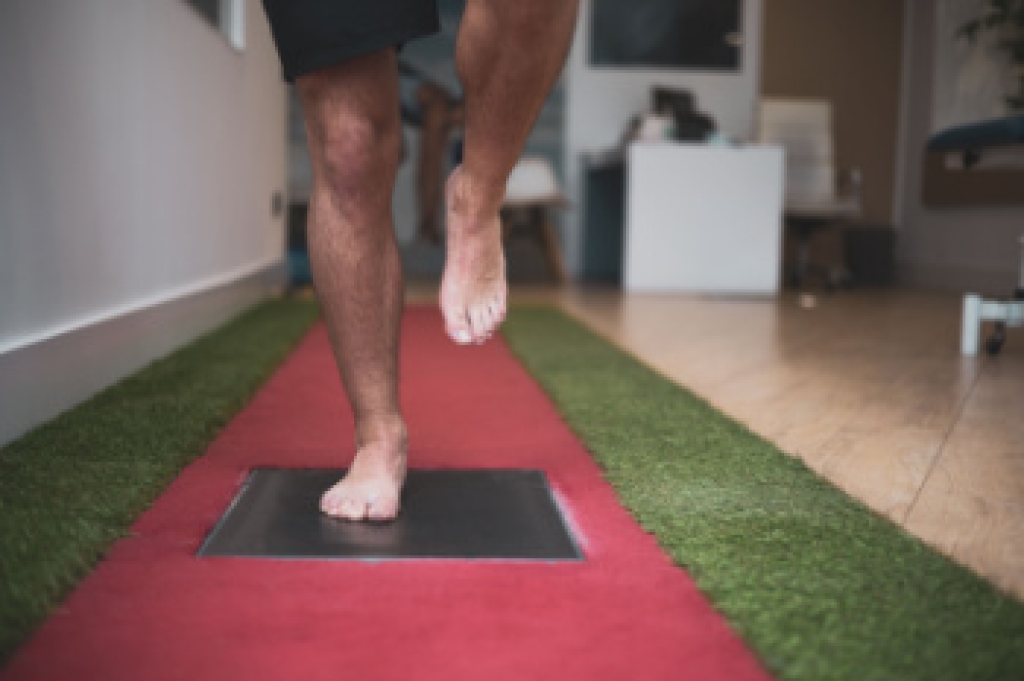Connect With Us
Blog
Blog
The Benefits of Wearing Shoes That Fit Properly
 When shoes fit correctly, it can be easier to complete daily activities. Wearing the right shoes may be helpful in protecting the body from injury, and the feet will generally feel comfortable. This is a result of proper support and adequate cushioning in the shoes. Research has indicated that it is beneficial to purchase shoes in the afternoon, when the feet are typically at their largest. It is important to ensure the toes have ample room to move freely, in addition to making sure your heels do not slip in the shoe. The type of shoes that are worn can influence the way you walk, and may affect the arches, joints, and foot muscles. If you would like to know more information about how to purchase properly fitted shoes, it is suggested that you consult with a podiatrist.
When shoes fit correctly, it can be easier to complete daily activities. Wearing the right shoes may be helpful in protecting the body from injury, and the feet will generally feel comfortable. This is a result of proper support and adequate cushioning in the shoes. Research has indicated that it is beneficial to purchase shoes in the afternoon, when the feet are typically at their largest. It is important to ensure the toes have ample room to move freely, in addition to making sure your heels do not slip in the shoe. The type of shoes that are worn can influence the way you walk, and may affect the arches, joints, and foot muscles. If you would like to know more information about how to purchase properly fitted shoes, it is suggested that you consult with a podiatrist.
Finding a properly-fitting shoe is important in reducing injuries and preventing foot problems. For more information about treatment, contact Patricia A. Kirk, DPM from Kirk Podiatry. Our doctor will treat your foot and ankle needs.
Proper Shoe Fitting
A common concern when it comes to foot health, having properly fitted shoes can help prevent injuries to the foot. Out feet affect our posture and gait, which in turn affects the biomechanics and overall bodily structure. With 33 joints, 26 bones, and over 100 ligaments, the potential for serious injury is much greater than one realizes. Although the feet cease growth in adulthood, they still change shape as they mature. Here are some factors to consider when it comes to investing in proper fitting shoes:
- Be sure the shoes fit correctly right away
- Ensure the ball of your foot fits comfortably in the widest portion of the shoes
- Even though they may look fashionable, improper fitting shoes can either create adverse conditions or exacerbate existing ones you may already have
- Walk along a carpeted surface to ensure the shoes comfortably fit during normal activity
Keeping in mind how shoes fit the biomechanics of your body, properly-fitting shoes are vitally important. Fortunately, it is not difficult to acquire footwear that fits correctly. Be sure to wear shoes that support the overall structure of your body. Do your feet a favor and invest in several pairs of well-fitted shoes today.
If you have any questions, please feel free to contact our office located in Lexington, TN . We offer the newest diagnostic and treatment technologies for all your foot care needs.
Congenital Foot Deformities and Early Care

Congenital foot deformities are structural abnormalities present at birth that affect the shape or function of an infant’s feet. One of the most recognized conditions is clubfoot, in which the foot turns inward and downward, making normal movement difficult without treatment. Early care often includes manual manipulations that gently guide the foot into a healthier position, followed by supportive methods to maintain correction as the child grows. A podiatrist can evaluate the deformity, create a personalized treatment plan, and guide families through each stage of care to improve long term mobility and foot health. If your child shows signs of a foot deformity, it is strongly suggested that you promptly consult a podiatrist who can help you with effective management tips.
Congenital foot problems require immediate attention to avoid future complications. If you have any concerns, contact Patricia A. Kirk, DPM of Kirk Podiatry. Our doctor can provide the care you need to keep you pain-free and on your feet.
Congenital foot problems are deformities affecting the feet, toes, and/or ankles that children are born with. Some of these conditions have a genetic cause while others just happen. Some specific foot ailments that children may be born with include clubfeet, polydactyly/macrodactyly, and cleft foot. There are several other foot anomalies that can occur congenitally. What all of these conditions have in common is that a child may experience difficulty walking or performing everyday activities, as well as trouble finding footwear that fits their foot deformity. Some of these conditions are more serious than others. Consulting with a podiatrist as early as possible will help in properly diagnosing a child’s foot condition while getting the necessary treatment underway.
What are Causes of Congenital Foot Problem?
A congenital foot problem is one that happens to a child at birth. These conditions can be caused by a genetic predisposition, developmental or positional abnormalities during gestation, or with no known cause.
What are Symptoms of Congenital Foot Problems?
Symptoms vary by the congenital condition. Symptoms may consist of the following:
- Clubfoot, where tendons are shortened, bones are shaped differently, and the Achilles tendon is tight, causing the foot to point in and down. It is also possible for the soles of the feet to face each other.
- Polydactyly, which usually consists of a nubbin or small lump of tissue without a bone, a toe that is partially formed but has no joints, or an extra toe.
- Vertical talus, where the talus bone forms in the wrong position causing other bones in the foot to line up improperly, the front of the foot to point up, and the bottom of the foot to stiffen, with no arch, and to curve out.
- Tarsal coalition, when there is an abnormal connection of two or more bones in the foot leading to severe, rigid flatfoot.
- Cleft foot, where there are missing toes, a V-shaped cleft, and other anatomical differences.
- Macrodactyly, when the toes are abnormally large due to overgrowth of the underlying bone or soft tissue.
Treatment and Prevention
While there is nothing one can do to prevent congenital foot problems, raising awareness and receiving neonatal screenings are important. Early detection by taking your child to a podiatrist leads to the best outcome possible.
If you have any questions, please feel free to contact our office located in Lexington, TN . We offer the newest diagnostic and treatment technologies for all your foot care needs.
Exploring the Challenges of Foot Drop

Foot drop is a condition in which a person has difficulty lifting the front part of the foot, often caused by nerve injury, muscle weakness, or neurological disorders such as stroke or neuropathy. It may look like the foot drags while walking, and many individuals develop a high-stepping gait to avoid tripping. Foot drop can feel awkward, tiring, or unstable, and some people notice numbness or tingling along the shin or top of the foot. Foot drop is a symptom rather than a standalone diagnosis, meaning the underlying cause must be identified for proper treatment. A podiatrist can begin by evaluating muscle strength, nerve function, and gait patterns to pinpoint the source of the problem. Treatment options may include bracing to support the foot, custom orthotics, or strategies to improve balance and mobility. Early intervention helps reduce long-term complications and improves confidence while walking. If you notice changes in your walking pattern or difficulty lifting your foot, it is suggested that you make an appointment with a podiatrist.
Foot Pain
Foot pain can be extremely painful and debilitating. If you have a foot pain, consult with Patricia A. Kirk, DPM from Kirk Podiatry. Our doctor will assess your condition and provide you with quality foot and ankle treatment.
Causes
Foot pain is a very broad condition that could be caused by one or more ailments. The most common include:
- Bunions
- Hammertoes
- Plantar Fasciitis
- Bone Spurs
- Corns
- Tarsal Tunnel Syndrome
- Ingrown Toenails
- Arthritis (such as Gout, Rheumatoid, and Osteoarthritis)
- Flat Feet
- Injury (from stress fractures, broken toe, foot, ankle, Achilles tendon ruptures, and sprains)
- And more
Diagnosis
To figure out the cause of foot pain, podiatrists utilize several different methods. This can range from simple visual inspections and sensation tests to X-rays and MRI scans. Prior medical history, family medical history, and any recent physical traumatic events will all be taken into consideration for a proper diagnosis.
Treatment
Treatment depends upon the cause of the foot pain. Whether it is resting, staying off the foot, or having surgery; podiatrists have a number of treatment options available for foot pain.
If you have any questions, please feel free to contact our office located in Lexington, TN . We offer the newest diagnostic and treatment technologies for all your foot care needs.
How Children’s Feet Grow and Change Over Time

Children’s feet go through constant change as they grow, developing from soft, flexible structures into strong, supportive foundations. In infancy and early childhood, the bones are still forming, and the arch is not yet visible because of natural fat padding. As kids become more active and start walking, running, and jumping, the muscles and ligaments strengthen, and the arches begin to take shape. Proper-fitting shoes are essential during these stages, as tight or poorly shaped footwear can interfere with normal development. Flat feet, in-turning toes, or uneven walking patterns are common early on, but should be monitored to ensure they improve with growth. Regular foot checks by a podiatrist help identify any concerns before they cause discomfort or affect mobility. If you notice that your child seems to be experiencing foot discomfort, unusual wear on your child’s shoes, or frequent tripping, it is suggested that you schedule a podiatric evaluation.
Making sure that your children maintain good foot health is very important as they grow. If you have any questions, contact Patricia A. Kirk, DPM of Kirk Podiatry. Our doctor can provide the care you need to keep you pain-free and on your feet.
Keeping Children's Feet Healthy
Having healthy feet during childhood can help prevent medical problems later in life, namely in the back and legs. As children grow, their feet require different types of care. Here are some things to consider...
Although babies do not walk yet, it is still very important to take care of their feet.
Avoid putting tight shoes or socks on his or her feet.
Allow the baby to stretch and kick his or her feet to feel comfortable.
As a toddler, kids are now on the move and begin to develop differently. At this age, toddlers are getting a feel for walking, so don’t be alarmed if your toddler is unsteady or ‘walks funny’.
As your child gets older, it is important to teach them how to take care of their feet.
Show them proper hygiene to prevent infections such as fungus.
Be watchful for any pain or injury.
Have all injuries checked by a doctor as soon as possible.
Comfortable, protective shoes should always be worn, especially at play.
If you have any questions, please feel free to contact our office located in Lexington, TN . We offer the newest diagnostic and treatment technologies for all your foot care needs.
Blog Archives
- 2025
- 2024
- 2023
